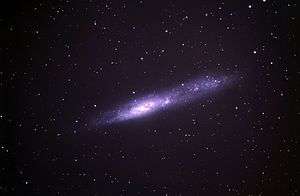NGC 55
| NGC 55 | |
|---|---|
 The irregular galaxy NGC 55, shot by the 3.6 meter telescope at ESO's La Silla observatory. | |
| Observation data (J2000 epoch) | |
| Constellation | Sculptor[1] |
| Right ascension | 00h 14m 53.6s[2] |
| Declination | −39° 11′ 48″[2] |
| Redshift | 129 ± 2 km/s[2] |
| Distance |
7.2 ± 0.7 Mly |
| Apparent magnitude (V) | 7.87[5][6] |
| Characteristics | |
| Type | SB(s)m[2] |
| Apparent size (V) | 32′.4 × 5′.6[2] |
| Other designations | |
| PGC 1014,[2] Caldwell 72, 2MASS J00145360-3911478, IRAS F00124-3929, ESO 293-50, MCG -07-01-013[5] | |
NGC 55, also occasionally referred to as The Whale Galaxy, is a Magellanic type barred spiral galaxy located about 7 million light-years away in the constellation Sculptor. Along with its neighbor NGC 300, it is one of the closest galaxies to the Local Group, probably lying between the Milky Way and the Sculptor Group.[7]
Nearby galaxies and group information
NGC 55 and the spiral galaxy NGC 300 have traditionally been identified as members of the Sculptor Group, a nearby group of galaxies in the constellation of the same name. However, recent distance measurements indicate that the two galaxies actually lie in the foreground.[8]
It is likely that NGC 55 and NGC 300 form a gravitationally bound pair.[4]
Visual appearance
.jpg)
The Webb Society Deep-Sky Observer's Handbook[9] writes the following about NGC 55: "Nearly edge-on and appears asymmetrical with some signs of dust near the bulge, which is diffuse, broad and somewhat elongated with the south edge sharp; southeast of the bulge it is strongly curved and lined with 4 or 5 faint knots; north edge of the curve is sharp." Burnham calls it "one of the outstanding galaxies of the southern heavens", somewhat resembling a smaller version of the Large Magellanic Cloud.[10]
See also
Notes
External links
| Wikimedia Commons has media related to NGC 55. |
- NGC 55 in Sculptor
- SEDS: Spiral Galaxy NGC 55
- NGC 55 on WikiSky: DSS2, SDSS, GALEX, IRAS, Hydrogen α, X-Ray, Astrophoto, Sky Map, Articles and images
References
- ↑ R. W. Sinnott, ed. (1988). The Complete New General Catalogue and Index Catalogue of Nebulae and Star Clusters by J. L. E. Dreyer. Sky Publishing Corporation and Cambridge University Press. ISBN 0-933346-51-4.
- 1 2 3 4 5 6 "NASA/IPAC Extragalactic Database". Results for NGC 55. Retrieved 2006-10-17.
- 1 2 Karachentsev, I. D.; Kashibadze, O. G. (2006). "Masses of the local group and of the M81 group estimated from distortions in the local velocity field". Astrophysics. 49 (1): 3–18. Bibcode:2006Ap.....49....3K. doi:10.1007/s10511-006-0002-6.
- 1 2 3 van de Steene, G. C.; et al. (2006). "Distance determination to NGC 55 from the planetary nebula luminosity function". Astronomy and Astrophysics. 455 (3): 891–896. Bibcode:2006A&A...455..891V. doi:10.1051/0004-6361:20053475.
- 1 2 "NGC 55". SIMBAD. Centre de données astronomiques de Strasbourg. Retrieved 2009-11-29.
- ↑ Armando, Gil de Paz; et al. (2007). "The GALEX Ultraviolet Atlas of Nearby Galaxies". Astrophysical Journal Supplement Series. 173 (2): 185–255. arXiv:astro-ph/0606440. Bibcode:2007ApJS..173..185G. doi:10.1086/516636.
- ↑ "New General Catalog Objects: NGC 50 - 99". cseligman.com. Retrieved 2017-12-12.
- ↑ I. D. Karachentsev; et al. (2003). "Distances to nearby galaxies in Sculptor". Astronomy and Astrophysics. 404 (1): 93–111. arXiv:astro-ph/0302045. Bibcode:2003A&A...404...93K. doi:10.1051/0004-6361:20030170.
- ↑ Jones, K. G. (1981). Webb Society Deep-Sky Observer's Handbook. Enslow Publishers. ISBN 0-89490-134-6. OL 8249797M.
- ↑ Robert Burnham, Jr. (1978). Burnham's Celestial Handbook. III. New York: Dover. p. 1733. ISBN 0-486-24065-7.